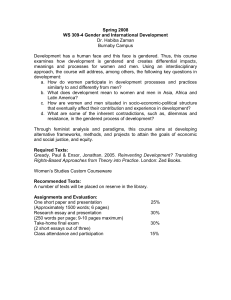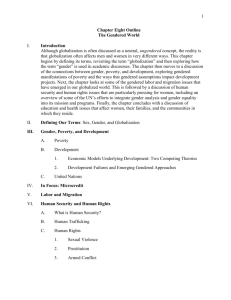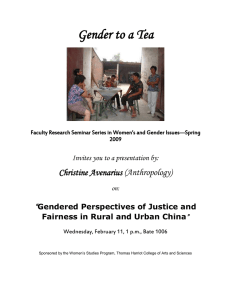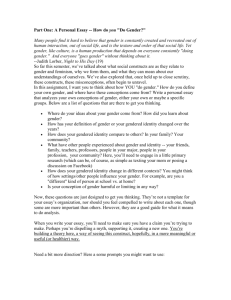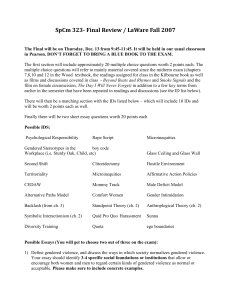ORIGINS OF GENDERED INSTITUTIONS: PREDICTING SEGREGATED RELIGIOUS RITUALS IN 73 PREMODERN SOCIETIES
advertisement
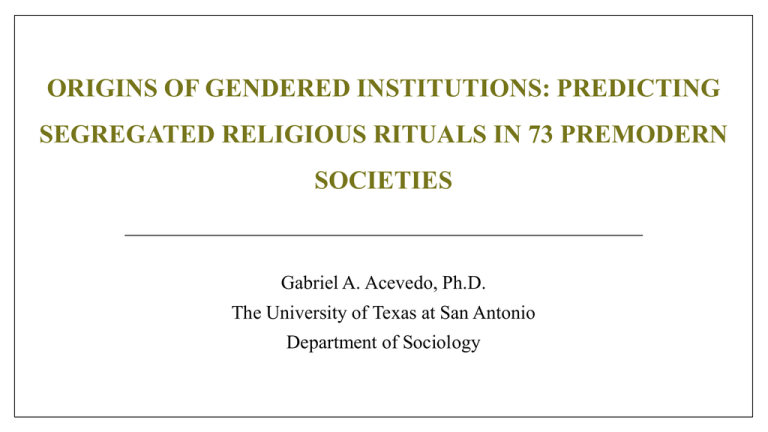
ORIGINS OF GENDERED INSTITUTIONS: PREDICTING SEGREGATED RELIGIOUS RITUALS IN 73 PREMODERN SOCIETIES Gabriel A. Acevedo, Ph.D. The University of Texas at San Antonio Department of Sociology Gendered Institutions Perspective • Gender • • • Embedded within social institutions both developed and currently dominated by men. Presented and interpreted from the perspective and viewpoint of men. And so, gender is not just a role, category, or identity. • Vital • • produced through organizational sites and cultural practices. element of gendered institutions The constructed ideologies of gender justify, explain, and legitimize This produces “personas that are appropriately gendered for the institutional setting” (Acker 1992: 568). Religion as a Gendered Institution • Religion and family as intertwined and interdependent social institutions • Central to religious doctrines are gendered relationships in society. • Religion • • • establishes the family paradigm Constructs gendered norms and expectations Reinforces patriarchal systems Reinforces traditional gender roles • Limits equal opportunities for women outside of domestic sphere (Baber and Allen 1992; Daly 1993; Goldenberg 1979). Religion as a Gendered Institution • Fundamentalist • • and orthodox denominations traditional views of family structure and functioning. Patriarchy as a core component of beliefs and practices • These views translate to acceptance and valuation of traditional gender expectations in both the private and public spheres. • Ongoing • • debate Patriarchal family structures having harmful outcomes Women reporting lower levels of perceived martial satisfaction. Traditional Islam • Islamic society organized around sex roles. • Muslim codes of conduct (“Sha’ria”) • religious and secular • Places premium on gender differences • Can be seen in religious practices: Mosques • Sex-segregated worship space and rituals • Female body provokes men and endangers moral behavior. • “…women must not take part in the public sphere.” (Kaya 2000:198-199). • Not separate but equal spaces Traditional Islam Religious Leadership • Patriarchal • Mosque leadership positions reserved exclusively for men. • Religious instruction thus provided by men Scripture • Qur’ānic interpretations and principles called “hadiths • Generated and disseminated by male religious leaders Veil • • • Gendered symbol and practice Justified through scriptural verses and authoritative texts This practice “concretizes” gender in everyday life. Religious Segregation in History • Judeo-Christianity • Catholicism • • Protestantism • • Gendered leadership Less hierarchical Sectarian Religious Movements • LDS, Jehovah’ s Witnesses, Other Theories of Gendered Institutions • Anthropologists, sociologists and psychologists have sought reasons explaining the universally higher status of men than of women • • • Cultural , religions, socioeconomic, and spatial factors (physical distance) How these contribute and perpetuate gender stratification Marxist feminists link the family with the economy. • • Patriarchy becomes the model for capitalist economic Men's power strengthened by their control of the best occupations outside of the domestic sphere. Methods • Data • Standard Cross Cultural Sample • Dependent Variable • v580. Participation in Collective Religious Ceremonies and Rituals (N=73) • Analytical Strategy Ordered Logistic Regression • Cumulative Odds predicting male dominated religious rituals • v580. Participation in Collective Religious Ceremonies and Rituals (SCCS N=73) Results • Descriptive Data & Measures of Central Tendency • Bivariate Correlations • Ordered Logits Table 1. Descriptive Statistics SCCS (n=73) % v580 Level of Religious Segregation Both,women more prominent (=0) Both, fairly equal participation (=1) Both, but males more common/promiment (=2) Only males (=3) v595 Mens domestic work Men do virtuall none (=0) Some mainly female (=1) v598 Extramarital affairs not allowed Not allowd/uncommon (=0) Allowed (=1) Rare (=2) v616 Preference for male children Male Preference (=0) Equal or female preference (=1) v618 Early training for adult duties Girls trained (=0) Equal training (=1) v624 Any belief women's status declined Yes (=0) Other (=1) v626 Belief women are inferior Yes (=0) No (=1) v630 Value placed on woman's life Low (=0) Other (=1) v633 Ritualized female solidarity scale Low female solidarity (=0) Other (=1) v61 Fixity of settlement v73 Community integration v634 Control over sex scale Mean SD Min Max 6.85 38.36 49.32 5.48 51.09 48.91 33.72 19.77 46.51 30.11 39.89 23.66 76.34 6.45 93.55 29.03 70.97 8.6 91.4 27.96 72.04 3.46 1.32 0.67 1.97 0.95 0.53 0 0 0 5 3 2 Table 2. Correlation Matrix Study Variables Cross Cultural Sample (v580) (v590) (v598) (v616) (v618) (v624) (v626) (v630) (580) Revonmale 1.00 (v590) Malewrk -0.18 1.00 (v598) femexmrnot -0.19 -0.09 1.00 (v616) malepref -0.17 0.03 0.01 1.00 (v618) femtrained -0.18 -0.01 -0.00 0.13 1.00 (v624) femdecline -0.07 -0.09 -0.06 0.01 0.16 1.00 (v626) feminferior -0.27 * 0.10 -0.10 0.30 ** 0.20 † 0.21 1.00 (v630)femnoval -0.21 † -0.16 0.09 0.46 *** 0.00 -0.08 * 0.14 1.00 (v633 femlowsolid -0.29 * -0.01 -0.07 0.16 0.16 0.12 0.44 *** -0.02 (v61) fixity 0.15 0.03 0.26 * -0.07 -0.22 * 0.02 -0.14 -0.06 (v73)Commint -0.10 0.05 0.10 -0.06 0.02 -0.07 0.08 -0.05 (v634)strictcontrol 0.04 0.09 0.12 -0.18 † -0.05 0.00 -0.25 * -0.11 † = p< .10; * = p < .05, ** = p < .01, *** = p < .001 (v633) 1.00 -0.09 -0.10 -0.11 (v61) 1.00 0.22 ** 0.12 (v73) (v634) 1.00 0.09 1.00 Table 3. Proportional Odds Ordered Logit Models for Male Dominated Religious Rituals (SCCS) v595 Male none/little domestic work (ommited = some) v616 Preference for male children (ommited = none) v61 Fixity of settlement (ordinal: low to high) v73 Community integration (ordinal: low to high) v598 Extramarital affairs not allowed (ommitted = rare) Not allowd/uncommon Allowed v618 Female early training for adult duties (ommited = equal) v633 Low female solidarity(ommited = other) v634 Control over sex scale (ordinal: low to high) v626 Belief women are inferior (ommited = no) v630 Low value placed on woman's life (ommited = other) v624 Any belief women's status declined (ommited = other) -2 Log L Likelihood ratio ᵡ² DF N † = p< .10; * = p < .05, ** = p < .01, *** = p < .001 Model 1 2.27 † 1.80 1.15 0.87 Model 2 2.33 † 1.60 1.05 0.83 0.45 0.32 1.71 3.79 * 1.03 147.81 6.78 † 4 73 128.60 17.16 * 9 73 Model 3 3.35 * 0.64 1.00 0.77 0.35 0.33 1.71 4.71 ** 0.91 1.26 15.49 ** 1.64 121.53 24.22 ** 12 73 Discussion and Conclusion Questions?
